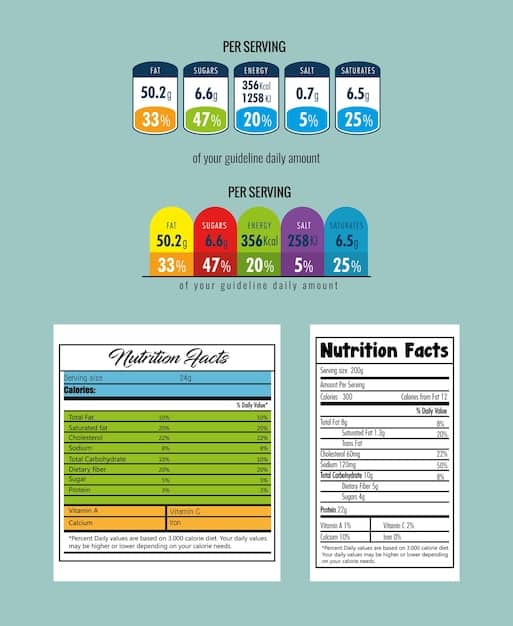Importing Food Products into the US: FDA Compliance Guide

Understanding FDA’s Role in Food Imports
The FDA plays a pivotal role in ensuring the safety and proper labeling of all food products entering the United States.
This oversight is critical for protecting public health and maintaining consumer confidence in the food supply.
The FDA’s regulations cover a wide range of areas, from facility registration to preventive controls and labeling requirements.
FDA’s Mission and Authority
The FDA’s mission is to protect and promote public health through the regulation and supervision of food safety, as well as drugs, medical devices, and cosmetics.
When it comes to food imports, the agency plays a critical role in ensuring that all products entering the US market meet established safety and labeling standards.
Its authority to regulate food imports is rooted in the Federal Food, Drug, and Cosmetic Act (FD&C Act), which grants the FDA broad enforcement powers to inspect, monitor, and take action against non-compliant shipments.
This legal framework enables the agency to maintain the integrity of the nation’s food supply and safeguard consumers from potential health risks.
Key Regulations and Guidelines
The FDA’s approach to food imports is guided by key regulations, including the Food Safety Modernization Act (FSMA), which emphasizes prevention over reaction.
There are also specific rules for products like seafood, dairy, and produce. Importers must understand these to ensure full compliance and avoid issues at the border.
- Prior Notice: Importers are required to provide prior notice to the FDA before shipping food products to the US.
- Facility Registration: Both domestic and foreign facilities that manufacture, process, pack, or hold food for human or animal consumption in the United States must register with the FDA.
- Labeling Requirements: Food labels must comply with specific FDA regulations regarding nutrition information, ingredient declaration, and allergen labeling.
Navigating the FDA’s regulatory landscape requires a thorough understanding of the applicable laws and regulations.
Staying informed and seeking expert guidance can help importers successfully navigate this complex process and avoid costly mistakes.
Facility Registration Requirements
Registering your facility with the FDA is a fundamental step in the process of importing food products into the US and a key requirement for meeting FDA regulations and ensuring compliance.
This registration provides the FDA with essential information about your facility’s location, operations, and the types of food handled, enabling the agency to monitor supply chains more effectively and respond swiftly to any potential safety concerns.
It also helps establish transparency and accountability across all points of the food production and distribution process, reinforcing consumer confidence in imported products.
Who Needs to Register?
Any facility, whether domestic or foreign, that manufactures, processes, packs, or holds food for human or animal consumption in the United States is required to register with the FDA.
This requirement applies broadly, not only to processing plants and warehouses but also to certain transportation hubs involved in the food supply chain.
Registration ensures that all parties handling food products are accountable and traceable, which is essential for maintaining safety and compliance throughout the import process.
How to Register
The registration process is relatively straightforward and can be completed online through the FDA’s Unified Registration and Listing System (FURLS).
To complete the process, applicants must provide key information about the facility, such as its legal name, physical address, contact details, and the categories of food products it manufactures, processes, packs, or stores.
Ensuring the accuracy of this information is crucial, as it forms the basis for FDA oversight and communication.

Maintaining Your Registration
Once registered, it’s essential to keep your registration information up to date. The FDA requires facilities to renew their registration every even-numbered year between October 1st and December 31st.
Failure to renew or keep information current can result in suspension of your facility’s registration.
Facility registration is more than just a bureaucratic requirement; it’s a cornerstone of the FDA’s food safety strategy.
By ensuring that all facilities are registered and their information is current, the FDA can better track and respond to potential food safety issues.
Understanding Prior Notice
Prior notice is another crucial requirement when importing food products into the US, playing a vital role in meeting FDA regulations and ensuring compliance.
By submitting advance notification about incoming shipments, importers enable the FDA to review and assess potential risks before the products reach US ports.
This proactive measure helps the agency detect and prevent unsafe, adulterated, or mislabeled items from entering the country, safeguarding both public health and the integrity of the food supply chain.
What is Prior Notice?
When to Submit Prior Notice
The timing for submitting prior notice varies based on the mode of transportation. For shipments arriving by land, the FDA requires that prior notice be submitted at least two hours before arrival.
For shipments arriving by air or sea, the notice must be submitted a minimum of four hours in advance.
Meeting these deadlines is essential to avoid delays, detentions, or possible rejection of the shipment at the port of entry.
Information Required for Prior Notice
Submitting prior notice requires accurate and detailed information about the food product and the shipment. Common mistakes can lead to delays or rejection of the shipment.
- Product Information: Include accurate details about the product’s name, manufacturer, and country of origin.
- Shipment Details: Provide information about the shipper, consignee, and transporter.
- Port of Entry: Specify the port where the shipment will enter the US.
Prior notice is a vital tool for the FDA in ensuring the safety and security of the food supply.
By providing timely and accurate information, importers can help facilitate the efficient processing of their shipments and avoid potential delays or penalties.
Labeling Requirements for Imported Foods
Proper labeling is a critical component of importing food products into the US and a key factor in meeting FDA regulations and ensuring compliance.
The FDA enforces strict labeling standards to guarantee that consumers receive clear, accurate, and complete information about the food they purchase.
Labels must not only reflect the product’s contents and nutritional value but also help protect public health by disclosing potential allergens and ensuring truthful marketing.
Compliance with these requirements is essential to avoid shipment rejections, recalls, or legal penalties.
General Labeling Requirements
The FDA’s general labeling requirements encompass a broad range of essential information, including the product’s name, net quantity, ingredient list, and a properly formatted nutrition facts panel.
These elements must be clearly presented on the label to ensure transparency and help consumers make informed choices based on nutritional content, portion size, and dietary needs.
Accurate labeling not only builds trust with consumers but also demonstrates compliance with federal standards, an essential step for any successful food import into the US.
Nutrition Facts Panel
The nutrition facts panel is a vital element of food labeling, offering consumers detailed insights into a product’s nutritional content, such as calories, total fat, carbohydrates, protein, and essential vitamins and minerals.
This information helps individuals make informed dietary choices based on their health goals and nutritional needs.
The FDA mandates strict formatting and content standards for the panel, including font size, layout, and the order of listed nutrients, to ensure clarity, consistency, and accuracy across all food products sold in the US.
Allergen Labeling
Allergen labeling is particularly important for consumers with food allergies. The FDA requires that food labels clearly identify any of the eight major food allergens: milk, eggs, fish, crustacean shellfish, tree nuts, peanuts, wheat, and soybeans.

Complying with the FDA’s labeling requirements can be challenging, but it’s essential for ensuring that your products can be legally sold in the US.
Working with experienced labeling professionals can help you navigate this complex process and avoid costly mistakes.
Detention Without Physical Examination (DWPE)
Detention Without Physical Examination (DWPE) is a process where the FDA may detain a product without physically examining it.
This typically occurs when there’s a history of non-compliance or a potential safety issue identified by the FDA.
Understanding DWPE is essential for importing food products into the US: Meeting FDA Regulations and Ensuring Compliance.
What Triggers DWPE?
Several factors can trigger a Detention Without Physical Examination (DWPE). Common causes include prior violations such as mislabeling, contamination, or failure to comply with established safety standards.
In addition to a company’s compliance history, the FDA also considers data from various sources, including foreign government inspections, industry alerts, and consumer complaints, to flag products that may present a risk.
When these red flags are identified, shipments may be detained without prior examination, underscoring the importance of maintaining consistent compliance.
How to Avoid DWPE
Being proactive is the most effective way to avoid Detention Without Physical Examination (DWPE).
This means implementing strong quality control systems, staying up to date with all applicable FDA regulations, and keeping thorough and accurate documentation for every shipment.
Regular internal audits and supplier checks can also help catch potential issues before they escalate.
If you do receive a DWPE notice, it’s crucial to act quickly, identify the root cause, correct any deficiencies, and provide the necessary documentation to demonstrate compliance and resolve the matter efficiently.
Steps to Take if Detained
If your product is detained under DWPE, you have several options. You can provide evidence to the FDA that your product complies with all applicable regulations.
You can also request a reconditioning of the product to bring it into compliance. Alternatively, you can choose to export the product or have it destroyed.
- Respond Promptly: Respond to the FDA’s detention notice quickly and professionally.
- Provide Documentation: Gather and submit all relevant documentation to support your case.
- Seek Expert Advice: Consult with experienced regulatory professionals to navigate the process effectively.
Detention Without Physical Examination can have significant financial and reputational consequences for importers.
By understanding the process and taking proactive steps to avoid it, you can protect your business and ensure the smooth import of your food products.
Strategies for Ensuring Compliance
Ensuring compliance with FDA regulations is an ongoing process that requires a proactive and systematic approach.
Implementing strong quality control measures helps ensure your food products meet FDA standards and reduces the risk of compliance issues.
Regular audits and staying updated on FDA regulation changes allow importers to adjust quickly and avoid delays or penalties.
Developing a Compliance Program
A comprehensive compliance program is the cornerstone of any successful import operation.
It should clearly outline the company’s policies and step-by-step procedures for meeting all applicable FDA regulations.
In addition to establishing standards, the program must include provisions for training employees, monitoring day-to-day compliance, and conducting regular internal audits to identify and correct potential issues before they escalate.
Third-Party Certification
Obtaining third-party certification from a recognized organization can add an extra layer of credibility and assurance that your products and processes align with FDA requirements.
These certifications typically involve thorough audits, on-site inspections, and documentation reviews, offering an objective evaluation of your compliance practices.
For importers, this independent verification not only reinforces product quality and safety but can also build trust with regulatory authorities and potential buyers in the U.S. market.
Staying Informed About Regulatory Changes
The FDA’s regulations are constantly evolving. It’s essential to stay informed about these changes and adjust your compliance program accordingly.
Subscribing to FDA updates, attending industry conferences, and consulting with regulatory experts are all effective ways to stay current.
Compliance is not just about avoiding penalties; it’s about protecting public health and building trust with consumers.
By taking a proactive approach to compliance, you can ensure that your products are safe, properly labeled, and meet all applicable FDA requirements.
| Key Point | Brief Description |
|---|---|
| 📝 Facility Registration | Register your food production facility with the FDA. |
| 📣 Prior Notice | Submit prior notice of your food shipment before arrival. |
| 🏷️ Labeling Rules | Adhere to all FDA labeling requirements. |
| 🚫 DWPE | Avoid Detention Without Physical Examination by staying compliant. |
Frequently Asked Questions (FAQ)
▼
FSMA is a law that focuses on preventing foodborne illnesses. It shifts the FDA’s focus from responding to contamination to preventing it, emphasizing practices like hazard analysis and preventive controls.
▼
Food facilities must renew their registration with the FDA every even-numbered year. The renewal period is between October 1st and December 31st. It’s important to not miss this deadline.
▼
Prior notice requires details such as the product name, manufacturer, shipper, and port of entry. Providing false or incomplete information can lead to detentions or other penalties for importers.
▼
A compliant food label must include the product name, net quantity, ingredient list, and nutrition facts panel. Allergen labeling is also essential, especially for the eight major food allergens, to prevent allergic reactions.
▼
If your shipment is detained, promptly respond to the FDA, provide necessary documentation, and seek expert advice. You may have the option to recondition the product or appeal the detention, depending on the reason.
Navigating the complexities of importing food products into the US can seem daunting, especially with the strict FDA regulations in place.
The process involves multiple steps, each requiring careful attention to detail and full compliance with legal requirements.
However, with a solid understanding of these regulations and a proactive approach to quality control and documentation, importers can manage the process effectively. Preparation and consistency are key to ensuring smooth entry into the U.S. market.
By prioritizing food safety, adhering to labeling requirements, and staying informed about regulatory changes, you can ensure the smooth import of your products and build a solid reputation in the US market.





